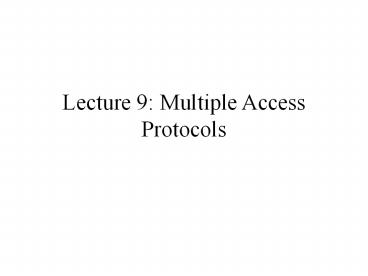Lecture 9: Multiple Access Protocols - PowerPoint PPT Presentation
Title:
Lecture 9: Multiple Access Protocols
Description:
Lecture 9: Multiple Access Protocols Taxonomy of Multiple Access Protocols Random Access Protocols Aloha Slotted Aloha Carrier sense multiple access (CSMA): Ethernet ... – PowerPoint PPT presentation
Number of Views:200
Avg rating:3.0/5.0
Title: Lecture 9: Multiple Access Protocols
1
Lecture 9 Multiple Access Protocols
2
Taxonomy of Multiple Access Protocols
- Random Access Protocols
- Aloha
- Slotted Aloha
- Carrier sense multiple access (CSMA) Ethernet
- Group random access
- Controlled Access Protocols
- Predetermined allocation (TDMA)
- Reservation protocols
- Token passing protocols
3
Aloha
- If you have a packet, just send it.
- If multiple people try it and so there is
collision, then try resending it later! - Theoretical analysis (based on Poisson
distribution) shows a throughput of only 18.
4
Slotted Aloha
- Synchronous, that is time is divided into slots
- Slot size is equal to the transmission time of a
packet - When you are ready, transmit at the start of the
time slot. - Doubles the efficiency of Aloha (38 throughput)
- But requires synchronization!
5
Carrier Sense Multiple Access
- CSMA
- Listen to channel. If busy then wait for a
random time and then listen again. If not busy
then transmit - Collision may still happen
6
p-persistent CSMA
- Quite like CSMA.
- But, when the channel is idle then you transmit
with probability p. Otherwise, even when it is
idle, you wait for a random time before you
listen to the channel.
7
CSMA/CD
- CSMA with collision detection(CD)
- Listen while you are sending packets
- Stop sending when collision happens
- Wait random time before you attempt to resend.
- IEEE 802.3 standard
- Used in coaxial cable. You do exponetial backoff.
8
Group Random Access
- Instead of random backoff, use a structured
search to find one unit to transmit - First enable a group.
- If collision happens, then divide the group into
two parts and let one part try.
9
Token Passing
- Form a circular list. Pass a token around.
Whoever has the token can transmit. - Only the station that wants to trasmit, seize the
token and release it after successful
transmission.
10
Reservation Aloha
- Channel is divided into time slots of equal size.
- Each slot is large enough to transmit a packet.
- Slots are arranged into frames of equal size.
- Frame size is proportional to propagation delay.
- Units compete for slots. Once a unit gets a
slot, it retains the slot (across frames) until
it no longer needs it. - Efficient for bursty data but no so for single
packet.
11
FIFO Reservation
- Channel is divided into slots. Units compete
and make reservation for these slots in FIFO
manner. - Every one keeps track of the order.
- After every M slots, one slot is broken into
small reservation slots using which units try to
reserve next M slots. - Efficient in handling bursty data. No frame size
limitation. But requires tracking of queue!
12
Round Robin
- Channel is divided into equal slots where each
unit is a owner of a slot. (Just like TDMA) - But, others can use the slot of a unit UNTIL the
unit wants it by creating a collision. - No activity is a signal for others to contend for
the slot. - Good for burst data. But contend using other
protocols for unused slots.

